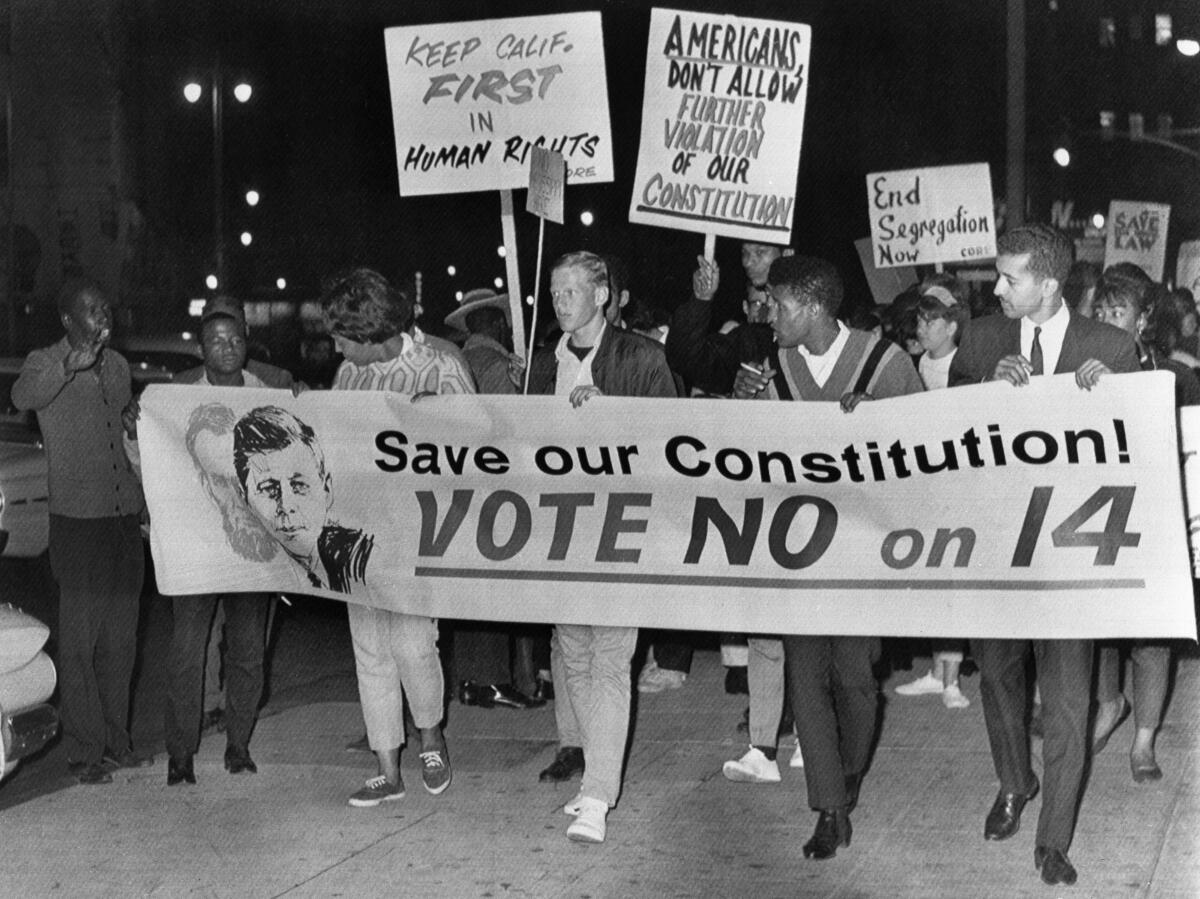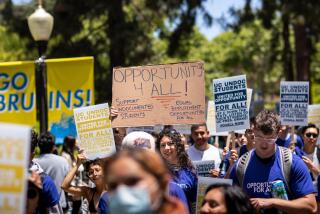Column: How a racist housing policy caused the biggest, bitterest brawl in Californiaâs Capitol

SACRAMENTO â Nationally, we just observed the 60th anniversary of the Rev. Martin Luther King Jr.âs March on Washington. In California, there wasnât a peep about the 60th anniversary of a historic civil rights triumph in this state.
Thatâs understandable. There are probably few people still around who know much about the Rumford Fair Housing Act, which produced arguably the biggest, bitterest brawl ever in Californiaâs Capitol.
Looking back, itâs almost inconceivable what the fight was about. It was over whether it should be legally permissible â never mind morally right â for homeowners and landlords to continue discriminating because of skin color in the sale and rental of housing.
Spurred by Democratic Gov. Pat Brown, the Democratic-controlled Legislature voted after much anguish to ban racial discrimination in housing. The public backlash was swift. Californians voted by nearly 2 to 1 the next year to legalize discrimination again. But the state and U.S. Supreme courts ultimately ruled that the votersâ action was unconstitutional.
âThe mood in California was as anti-equality â by legislative edict and local ordinances â as you can imagine,â says former Assembly Speaker and San Francisco Mayor Willie Brown, a legendary Black politician, recalling the mid-1960s.
âThe Rumford Act was considered a no-no.â
Moods across America were ugly in 1963.
In 1964, white Californians overwhelmingly voted to make segregation a part of the stateâs Constitution with the passage of Prop 14.
Birmingham, Ala., Police Chief Bull Connor turned dogs and fire hoses on civil rights marchers. Alabama Gov. George Wallace stood in the schoolhouse door vowing to block integration. Civil rights leader Medgar Evers was shot to death in Mississippi. Racists bombed a Birmingham church, killing four little girls.
In Sacramento, Gov. Brown daringly proposed legislation to end racial discrimination in housing. âNo man should be deprived of the right of acquiring a home of his own because of the color of his skin,â the governor declared.
Those were fighting words in the mid-1960s.
Unlike the Jim Crow South, California did not have officially segregated schools or separate drinking fountains for white and Black people. But de facto housing segregation was common. People of color were barred by local covenants from many white neighborhoods.
Californiaâs demographics were far different back then. More than 80% of the population was white. Around 9% was Latino, 5.6% Black and roughly 2% Asian. Today, the Black population is roughly the same, but whites are only 35%. Latinos are the largest ethnic group at 39%, with Asians and Pacific Islanders at 16%.
The housing bill was carried by â and unofficially named after âAssemblyman Byron Rumford (D-Berkeley), the first Black legislator elected from Northern California. Then, there were only three Black lawmakers out of 120. Today there are 12.
In a scene that couldnât happen today because of tighter security â and hasnât happened since â scores of civil rights demonstrators occupied the Capitolâs second-floor rotunda between the two legislative chambers for weeks. They slept on the tile floor at night and sang âWe Shall Overcomeâ during the day â ticking off many lawmakers but also applying pressure.
Actors Marlon Brando and Paul Newman visited one day to root on the protesters and publicize their cause. The governor showed up once to thank the demonstrators, bringing along two grandchildren.
Senate leader Hugh Burns, a conservative Democrat from Fresno, tried to prevent a vote on the bill as the Legislature approached mandatory adjournment on the final night of its annual session. But Assembly Speaker Jesse âBig Daddyâ Unruh of Inglewood, a civil rights champion, threatened to kill all Senate bills pending in his house unless Burns freed Rumfordâs measure.
A compromise version narrowly passed the Senate literally at the 11th hour, then breezed through the Assembly seven minutes before the midnight adjournment.
But first Unruh, a Texas sharecropperâs son who understood white racism, rose on the Assembly floor and cautioned colleagues about the political dangers of getting too far ahead of the citizenry.
Every metropolitan area in the nation is racially segregated, and Los Angeles is no exception.
He was immediately proved correct. The California Real Estate Assn. launched a repeal effort, Proposition 14, that became one of the most emotional and vitriolic initiative campaigns in state history. The outcome was never in doubt.
The Los Angeles Times endorsed the repeal, editorializing that housing discrimination was essentially a âbasic property right.â
Brown called Proposition 14 sponsors âshock troops of bigotry.â But his forceful advocacy of the Rumford Act contributed significantly to the governorâs reelection defeat in 1966. Newcomer Ronald Reagan trounced him in a landslide.
Rumford also lost a state Senate race.
Reagan attracted voters by vowing to wipe the Rumford Act off the books. But once in office he really never tried. Give him credit for that much.
Unruh appointed a white moderate Republican, Assemblyman Bill Bagley of San Rafael, to head a committee created to fashion a compromise. But Bagley, one of only a few Republicans who voted for the act, never convened the committee and stalled until the courts declared Proposition 14 unconstitutional.
The Rumford Act ultimately evolved into todayâs Fair Employment and Housing Act, which some Black legislators contend isnât being adequately enforce â particularly laws against workplace and rental discrimination.
âThe state agency is really understaffed and overburdened,â asserts Sen. Lola Smallwood-Cuevas (D-Los Angeles). âMuch of it has been gutted.â
Sheâs pushing a bill to permit local government enforcement of workplace anti-discrimination laws. But Gov. Gavin Newsom vetoed a similar measure for Los Angeles County three years ago, stating it âcould create confusion, inconsistent enforcement ⌠and increase costs.â
âCalifornia proclaims to be the vanguard of progressive values and social justice, yet we have not invested in our civil rights infrastructure,â Smallwood-Cuevas says.
âWe have a long way to go when it comes to racial justice in the workforce and in housing.â
Yes. But the bitter struggle over the Rumford Act reminds us of how far weâve come in 60 years.
More to Read
Sign up for Essential California
The most important California stories and recommendations in your inbox every morning.
You may occasionally receive promotional content from the Los Angeles Times.











